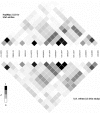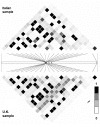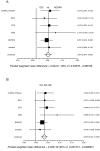A common haplotype of the glucokinase gene alters fasting glucose and birth weight: association in six studies and population-genetics analyses - PubMed (original) (raw)
. 2006 Dec;79(6):991-1001.
doi: 10.1086/509517. Epub 2006 Oct 6.
Vanessa J Clark, Yudong Qian, Yoav Ben-Shlomo, Nicholas Timpson, Shah Ebrahim, Debbie A Lawlor, Marcus E Pembrey, Susan Ring, Terry J Wilkin, Linda D Voss, Alison N Jeffery, Brad Metcalf, Luigi Ferrucci, Anna Maria Corsi, Anna Murray, David Melzer, Bridget Knight, Bev Shields, George Davey Smith, Andrew T Hattersley, Anna Di Rienzo, Tim M Frayling
Affiliations
- PMID: 17186458
- PMCID: PMC1698701
- DOI: 10.1086/509517
A common haplotype of the glucokinase gene alters fasting glucose and birth weight: association in six studies and population-genetics analyses
Michael N Weedon et al. Am J Hum Genet. 2006 Dec.
Abstract
Fasting glucose is associated with future risk of type 2 diabetes and ischemic heart disease and is tightly regulated despite considerable variation in quantity, type, and timing of food intake. In pregnancy, maternal fasting glucose concentration is an important determinant of offspring birth weight. The key determinant of fasting glucose is the enzyme glucokinase (GCK). Rare mutations of GCK cause fasting hyperglycemia and alter birth weight. The extent to which common variation of GCK explains normal variation of fasting glucose and birth weight is not known. We aimed to comprehensively define the role of variation of GCK in determination of fasting glucose and birth weight, using a tagging SNP (tSNP) approach and studying 19,806 subjects from six population-based studies. Using 22 tSNPs, we showed that the variant rs1799884 is associated with fasting glucose at all ages in the normal population and exceeded genomewide levels of significance (P=10-9). rs3757840 was also highly significantly associated with fasting glucose (P=8x10-7), but haplotype analysis revealed that this is explained by linkage disequilibrium (r2=0.2) with rs1799884. A maternal A allele at rs1799884 was associated with a 32-g (95% confidence interval 11-53 g) increase in offspring birth weight (P=.002). Genetic variation influencing birth weight may have conferred a selective advantage in human populations. We performed extensive population-genetics analyses to look for evidence of recent positive natural selection on patterns of GCK variation. However, we found no strong signature of positive selection. In conclusion, a comprehensive analysis of common variation of the glucokinase gene shows that this is the first gene to be reproducibly associated with fasting glucose and fetal growth.
Figures
Figure 1.
LD structure of glucokinase. _r_2 values between the 84 SNPs across a 116-kb region are presented. Arrows indicate tSNPs used in association study.
Figure 2.
Comparison of LD structure determined in this study with that determined from HapMap 2 data. The LD structures are based on the _r_2 values between the 17 SNPs that are present in both data sets.
Figure 3.
Comparison of LD structure determined for 16 Italians from the Natural Selection study with that determined from U.K. samples used for the tSNP-association study. The LD structure is based on the _r_2 and values between 20 SNPs that are present in both data sets.
Figure 4.
A, Meta-analysis of the fasting glucose association results of rs1799884 AA and AG versus GG for all studies. Studies are ordered by ascending age of the cohort. Heterogeneity
_P_=.94
; combined
_P_=1×10-9
. B, Meta-analysis of the fasting glucose association results of rs3757840. The effect size per allele is presented. Heterogeneity
_P_=.56
; combined
_P_=8×10-7
.
Figure 5.
Meta-analysis of the pairwise differences between haplotypes of rs1799884 and rs3757840 across fasting glucose. A, GA versus GC. B, AA versus GA. C, AA versus GC. Heterogeneity
_P_=.40
, .41, and .65, respectively.
Similar articles
- Genetic regulation of birth weight and fasting glucose by a common polymorphism in the islet cell promoter of the glucokinase gene.
Weedon MN, Frayling TM, Shields B, Knight B, Turner T, Metcalf BS, Voss L, Wilkin TJ, McCarthy A, Ben-Shlomo Y, Davey Smith G, Ring S, Jones R, Golding J, Byberg L, Mann V, Axelsson T, Syvänen AC, Leon D, Hattersley AT. Weedon MN, et al. Diabetes. 2005 Feb;54(2):576-81. doi: 10.2337/diabetes.54.2.576. Diabetes. 2005. PMID: 15677518 - Pregnancy outcome in patients with raised blood glucose due to a heterozygous glucokinase gene mutation.
Spyer G, Macleod KM, Shepherd M, Ellard S, Hattersley AT. Spyer G, et al. Diabet Med. 2009 Jan;26(1):14-8. doi: 10.1111/j.1464-5491.2008.02622.x. Diabet Med. 2009. PMID: 19125755 - Hyperglycemia and Adverse Pregnancy Outcome (HAPO) study: common genetic variants in GCK and TCF7L2 are associated with fasting and postchallenge glucose levels in pregnancy and with the new consensus definition of gestational diabetes mellitus from the International Association of Diabetes and Pregnancy Study Groups.
Freathy RM, Hayes MG, Urbanek M, Lowe LP, Lee H, Ackerman C, Frayling TM, Cox NJ, Dunger DB, Dyer AR, Hattersley AT, Metzger BE, Lowe WL Jr; HAPO Study Cooperative Research Group. Freathy RM, et al. Diabetes. 2010 Oct;59(10):2682-9. doi: 10.2337/db10-0177. Epub 2010 Aug 3. Diabetes. 2010. PMID: 20682688 Free PMC article. - Recognition and Management of Individuals With Hyperglycemia Because of a Heterozygous Glucokinase Mutation.
Chakera AJ, Steele AM, Gloyn AL, Shepherd MH, Shields B, Ellard S, Hattersley AT. Chakera AJ, et al. Diabetes Care. 2015 Jul;38(7):1383-92. doi: 10.2337/dc14-2769. Diabetes Care. 2015. PMID: 26106223 Review. - The Challenges of Treating Glucokinase MODY during Pregnancy: A Review of Maternal and Fetal Outcomes.
Kirzhner A, Barak O, Vaisbuch E, Zornitzki T, Schiller T. Kirzhner A, et al. Int J Environ Res Public Health. 2022 May 14;19(10):5980. doi: 10.3390/ijerph19105980. Int J Environ Res Public Health. 2022. PMID: 35627517 Free PMC article. Review.
Cited by
- Maternal Preconception Glucose Homeostasis and Insulin Resistance Are Associated with Singleton and Twin Birthweight of Neonates Conceived by PCOS Women Undergoing IVF/ICSI Cycles.
Jiang H, Guo Y, Chen L, Shi H, Huang N, Chi H, Yang R, Long X, Qiao J. Jiang H, et al. J Clin Med. 2023 Jun 5;12(11):3863. doi: 10.3390/jcm12113863. J Clin Med. 2023. PMID: 37298057 Free PMC article. - Potential impact of GCK, MIR-196A-2 and MIR-423 gene abnormalities on the development and progression of type 2 diabetes mellitus in Asir and Tabuk regions of Saudi Arabia.
Mir MM, Mir R, Alghamdi MAA, Wani JI, Elfaki I, Sabah ZU, Alhujaily M, Jeelani M, Marakala V, Alharthi MH, Al-Shahrani AM. Mir MM, et al. Mol Med Rep. 2022 May;25(5):162. doi: 10.3892/mmr.2022.12675. Epub 2022 Mar 16. Mol Med Rep. 2022. PMID: 35293603 Free PMC article. - Investigation of maternal polymorphisms in genes related to glucose homeostasis and the influence on birth weight: a cohort study.
Alves LNR, Pereira M, Dos Santos JA, Dos Santos EVW, Carvalho GQ, Santana JDM, Tavares EA, Fernandes MDB, Dos Santos DB, Louro ID. Alves LNR, et al. J Pediatr (Rio J). 2022 May-Jun;98(3):296-302. doi: 10.1016/j.jped.2021.06.007. Epub 2021 Sep 9. J Pediatr (Rio J). 2022. PMID: 34508664 Free PMC article. - Harnessing Human Microphysiology Systems as Key Experimental Models for Quantitative Systems Pharmacology.
Taylor DL, Gough A, Schurdak ME, Vernetti L, Chennubhotla CS, Lefever D, Pei F, Faeder JR, Lezon TR, Stern AM, Bahar I. Taylor DL, et al. Handb Exp Pharmacol. 2019;260:327-367. doi: 10.1007/164_2019_239. Handb Exp Pharmacol. 2019. PMID: 31201557 Free PMC article. - Genetic risk score of common genetic variants for impaired fasting glucose and newly diagnosed type 2 diabetes influences oxidative stress.
Kim M, Kim M, Huang L, Jee SH, Lee JH. Kim M, et al. Sci Rep. 2018 May 18;8(1):7828. doi: 10.1038/s41598-018-26106-z. Sci Rep. 2018. PMID: 29777116 Free PMC article.
References
Web Resources
- Kbioscience, http://www.kbioscience.co.uk/
References
- Bjornholt J, Erikssen G, Aaser E, Sandvik L, Nitter-Hauge S, Jervell J, Erikssen J, Thaulow E (1999) Fasting blood glucose: an underestimated risk factor for cardiovascular death: results from a 22-year follow-up of healthy nondiabetic men. Diabetes Care 22:45–49 - PubMed
- Charles MA, Fontbonne A, Thibult N, Warnet JM, Rosselin GE, Eschwege E (1991) Risk factors for NIDDM in white population: Paris prospective study. Diabetes 40:796–799 - PubMed
- Farmer G, Russell G, Hamilton-Nicol DR, Ogenbede HO, Ross IS, Pearson DW, Thom H, Kerridge DF, Sutherland HW (1988) The influence of maternal glucose metabolism on fetal growth, development and morbidity in 917 singleton pregnancies in nondiabetic women. Diabetologia 31:134–14110.1007/BF00276845 - DOI - PubMed
Publication types
MeSH terms
Substances
Grants and funding
- G0500070/MRC_/Medical Research Council/United Kingdom
- Z99 AG999999/ImNIH/Intramural NIH HHS/United States
- R01 DK056670/DK/NIDDK NIH HHS/United States
- F32 DK066974/DK/NIDDK NIH HHS/United States
- WT_/Wellcome Trust/United Kingdom
- G9815508/MRC_/Medical Research Council/United Kingdom
- DK66974/DK/NIDDK NIH HHS/United States
LinkOut - more resources
Full Text Sources
Medical
Miscellaneous




